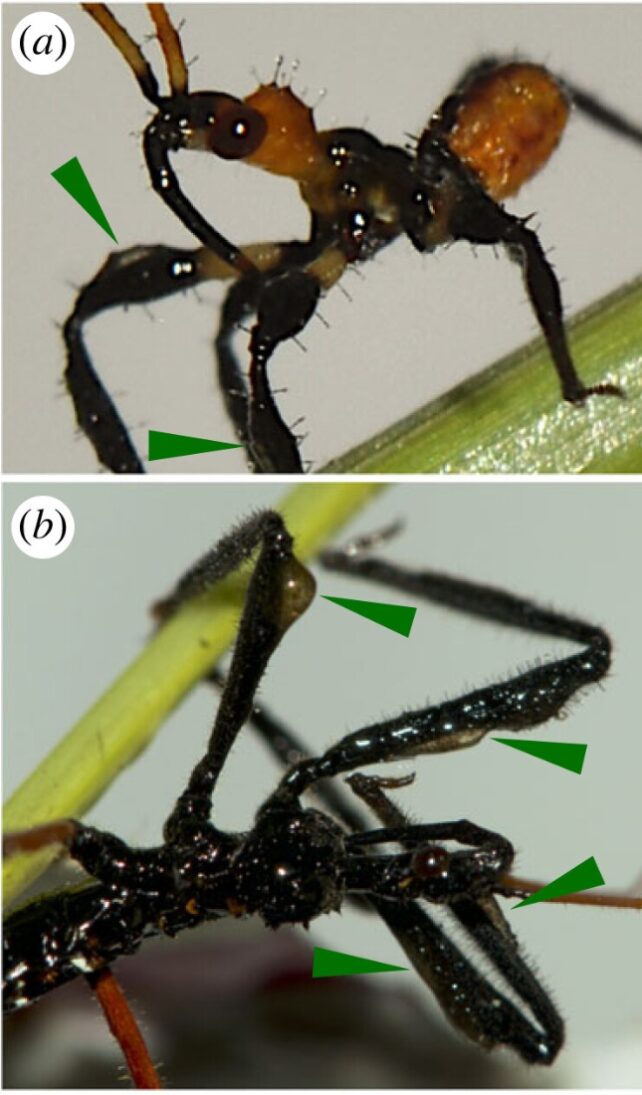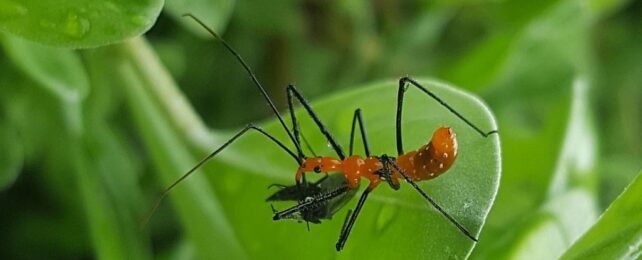In Australia, assassin bugs use a lethal tool to ensnare snacks: resin from spinifex grass. Recent research shows that the crawly critters slather themselves in the gluey gum to catch and keep their prey.
While unusual, some insects employ tools, from ants using particles to build bridges and beetle babies using poop as a parasite deterrent. Previous reports of assassin bugs collecting plant resins suggest this species uses tools more frequently than most.
The authors say this makes assassin bugs "a particularly promising case for understanding the ecological and behavioral conditions that facilitated the otherwise unlikely evolution of tool-use."
Because tool use requires a level of complex cognition, it was once thought to be a way to set humans apart from other animals, but researchers are now finding more and more examples of tool use across the animal kingdom.
Humans were even using tools before our thumbs fully developed dexterity, and it seems the earliest tools were not even human-made. Dolphins protect their beaks with sea sponges, pigs use sticks, and even brainy birds and bees are in on it.
Scientists had a hunch that assassin bugs' hunting success would increase if they coated themselves in the sticky resin of plants, but this had not been tested in experiments.
Macquarie University biologists Fernando Soley and Marie Herberstein observed 125 Australian assassin bugs from the undescribed species Gorareduvius from Western Australia's Kimberley region in wild conditions and in a nearby makeshift lab in a tent.
Australian assassin bugs are commonly seen lounging on Triodia stems, a native tussock grass commonly referred to as spinifex. It's found in dry regions of Australia and produces a sticky resin that the first Australians valued for its use in making hunting tools.
Soley and Herberstein predicted that if the resin is used as a tool, the bugs covered in resin will be better at catching prey than bugs not covered in resin. They took 26 assassin bugs found near or on curly spinifex (Triodia bitextura) back to their glamorous tent laboratory for investigation.
The researchers put the insects in a glass jar with a stick and introduced two kinds of prey: flies and ants. Then they used makeup removal pads to carefully wipe the resin off the insects' bodies, and the experiment was repeated.
The bugs were generally more successful at catching ants than flies, and importantly, they were more effective at catching prey when they had resin on their bodies, regardless of the type of prey.
Resin-covered insects were 26 percent more successful at capturing either type of prey than their unarmed counterparts. Flies are tricky to catch even on a good day, and without resin, 64 percent of the flies that Gorareduvius touched got away.
Both in the wild and the lab, researchers observed Gorareduvius scraping the resin off the spinifex leaves and meticulously applying it to their bodies, especially on their front legs. Even newly hatched and isolated nymphs were found to be coating themselves in resin, suggesting that this behavior is ingrained in the insects.
This meets the widely-used definitions of tool use, according to the authors.
"Assassin bugs manipulated an environmental item (the resin), by taking it out of its usual context and applying it onto their bodies," they write, "Thus gaining a selective advantage through improved prey capture."
The term assassin bug groups a variety of insects that are united by the gruesome way they kill their prey. Typically the predator will pierce the prey with its proboscis, pump digestive enzymes inside that will paralyze and kill it, and then drain the prey of its liquid contents, leaving behind an empty shell.

"Prey never appeared to be fully stuck to the resinous surface of the assassin bugs," Soley and Herberstein explain. "Rather, it appears that brief, temporary adhesion, delayed prey responses sufficiently enough for the assassin bugs to grasp and stab their prey".
So although resin does not guarantee success, it's a tool to slow this Aussie bug's prey down just enough for the assassin bug to grab and kill it.
The study has been published in Biology Letters.
